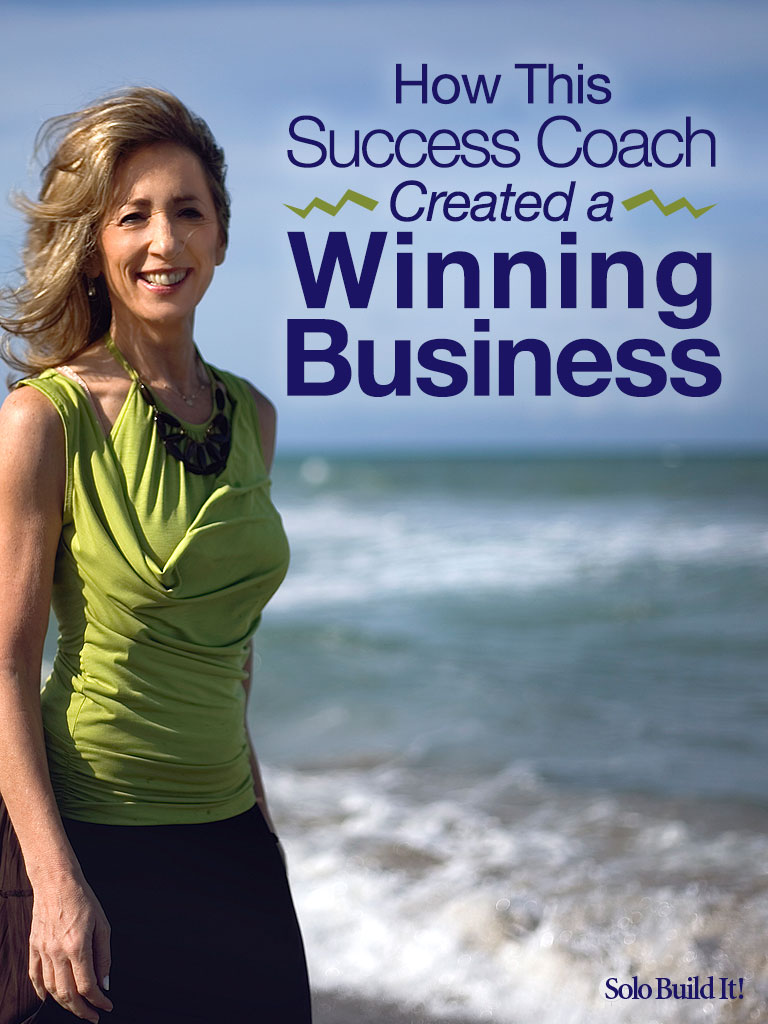
My philosophy is to give freely and not hold anything back. The things I teach are easier done when you have an audio guide. So, I offer my written content free and make a profit from audio programs, training and coaching.Mandy Bass from mindtosucceed.com
Mandy Bass was one of the first female success coaches in the United States when she founded her training and coaching company in 1996. As the years passed, it became more difficult and more expensive to fill seminar rooms, so she decided to take her business online.
How she did this, and why it has worked so well for her, becomes clear in our interview. You’ll also learn some excellent tips about creating audio products, and how she managed to sell 1,000 copies of her new book in a single day.
1. Mandy, you found your life’s calling after taking a course called the “Silva Method.” Can you tell us more about that, and how it led you to create www.MindtoSucceed.com?
The Silva Method is an experiential mind-training course that teaches how to quiet your mind and focus your thinking to solve problems and achieve the outcomes you want. Almost overnight I went from being a stressed out, anxious insomniac to a rested, peaceful, happy, successful person who felt in control of my life.
I was so impressed, I took instructor training and offered the course in public seminars for more than ten years. I also trained new teachers of the method and then started learning and teaching other modalities such as hypnosis and Neuro Linguistic Programming (NLP).
As the years passed, it became harder and more expensive to fill a seminar room so I took that business online, adding other methods and modalities that worked for me and my clients.
Several years later, she made another critical business decision: she expanded her offline training business with an online presence. This opened up a whole range of new growth possibilities, from reaching a much larger audience to earning passive income with the sales of her products.

2. You obviously chose your niche, mind power techniques, out of a deep fascination for this topic. But how did you know that it also had good business potential?
Though my site was always about using the power of the mind, mind power techniques was not my first seed word. Originally it was “self hypnosis.”
After a couple of years I went through the whole SBI! Action Guide and realized that the reason I wasn’t getting enough traffic was that there was not enough demand for the keywords (or topics) I had written about.
I hired an SBI! Professional and he helped me decide on “mind power techniques.”
You are in the business of delivering content that people want, right? So you need to know what terms people are searching for at Google and the other search engines.
As an SBI! member (“SBIer”), you’ll use a tool called Brainstorm It! for your keyword research. It not only finds way more search terms that you could ever think up, it applies classic supply-and-demand principles to point out what topics you should write about.
To start the keyword research, you enter the “seed word” into Brainstorm It!. In Mandy’s case, her original seed word was “self hypnosis.” The tool then brought back hundreds of keywords related to “self hypnosis.” These keyword phrases can either contain the seed word (e.g., “learn self hypnosis,” “self hypnosis benefits”) or not contain it, but still be relevant to the overall topic (e.g., “hypnotherapy,” “relax through meditation”).
You’ll repeat and refine your keyword brainstorming and analysis until you’re satisfied that you have found a topic or niche concept that has enough potential to become a viable business.
Some SBIers settle on the wrong niche in their first attempt, especially if they don’t follow the SBI! Action Guide closely. That’s what happened to Mandy. But she realized her mistake and — with the help of an experienced coach (available to SBI! members only) — she took her online business into a more promising direction.

3. Tell us about your philosophy regarding content. How do you know what your prospective customers are looking for? Where does this information come from?
I have been teaching these techniques for over twenty years, so I have a lot of material and different applications to fill hundreds of pages. Most of the info comes from my head, peppered with new research that supports whatever I am teaching.
My philosophy is to give freely and not hold anything back. The things I teach are easier done when you have an audio guide. So, I offer my written content free and make a profit from audio programs, training and coaching.
I offer a 100% guarantee on everything I sell. No questions asked. I know that some people will take advantage because you can’t force people to destroy a digital file. But I don’t spend energy worrying about things like that. In my world view, giving is receiving. If people steal, that is their burden to bear, not mine. There are enough honest people in the world for me to make a living.
Mandy has that knowledge in spades, acquired during her many years of teaching and coaching offline.
But, unless your website is just a hobby, you also need to make sure that you write about topics people are interested in. That’s what the keyword research we discussed in TAKEAWAY #2 is all about. So we asked Mandy if she supports her content decisions with keyword research in Brainstorm It!. She said:
“I typically know what I want to write about, then I try to find a keyword that fits in with that article. To me, this is the hardest part of writing an article; sometimes I get stuck there and don’t write the article at all because I can’t find a winnable keyword.
That is the difficult part of having the info in your head you want to share! I think it is easier to approach your site the other way round, i.e. find a good keyword, do the research, write the article. But that is not the way my brain works.”
In an ideal world, the keywords you find with Brainstorm It! would all have good numbers (high demand and low supply, which helps you “win” high positions at the search engines) and be perfectly aligned with what you want to write about.
As we all know, we don’t live in such a perfect world. So, by all means, let your content decisions be guided by keyword research as far as possible. However, you are the expert in your niche. If there’s a topic you simply know is important for your audience, write about it even if there is no “winnable” keyword.
4. In your store, you sell various personal growth exercises and audio trainings. Can you share your best tips about how to create and sell audio products?
If you are a beginner, the easiest way to create an audio product is to offer live web classes and record them.
Three reasons:
- Urgency: You will have a sense of urgency to organize and create good content when you have people signed up for a class.
- Market Research: If you can’t get people to come to a live class for whatever it is you’re offering, they probably won’t buy that product from you. Why bother creating something if the demand isn’t there?
- Quality: It’s boring to listen to someone reading a script to the ether. Don’t do that! While it’s true that you can get much better sound quality offline with good equipment, delivery sounds more natural and interesting when people are speaking to other people.
From a sales standpoint I have had more success creating sales funnels (with upsells and downsells) for audio products than with the store model — but the store model makes the delivery easier.
So one of my goals for the next year is figuring out how I can integrate the two strategies.
Live classes are a natural fit if your niche is related to training and coaching, as in Mandy’s case. But even if it isn’t, you might find an angle that works. For example, you could offer an “Ask Me Anything” session where people can ask whatever questions they have about your topic.
We were intrigued by Mandy’s remark of using a sales funnel versus a store. So we asked her this follow up question…
What you have now on your site is a Shopify store. How would a sales funnel for the same products look?

A sales funnel would lead each buyer down a specific and unique path that complements what they are buying. Instead of the buyer seeing all the items in the store, you can offer them add-on items that complement what they have already chosen.
So, for example, let’s say someone bought a “Relaxation” audio. During the checkout process, I could offer them another audio with relaxing music and affirmations for stress reduction for a low-price, and perhaps a sleep hypnosis program because people who are stressed out typically have problems sleeping. I could also offer them a lavender pillow, stress ball or some other item.
Or if they bought my “how to” self-hypnosis audio program I could offer them a live web class on the same subject and/or my “Ignite Your Secret Power” audio program, which will give them additional tools and techniques that they can use with self-hypnosis.
Each upsell in the funnel could have a video explaining why that particular product or program is recommended for them. Does that make sense?
Of course, the additional product needs to be relevant, and offer a clear, additional benefit to the customer.
5. Do you have other income streams, apart from selling your digital products, and how do they perform?
Most of my income comes from helping other business owners create successful businesses, i.e. consulting, training and speaking. That business informs creation of my digital products.
Her website reinforces her authority in her field and allows her to reach a wider audience, which in turn brings in new clients for her offline business. A perfect synergy! And hers is not the only online-offline business success story!
6. You recently published your first book on Amazon. What inspired you to write the book? Any advice for launching a book successfully?
In February 2016 I was brutally assaulted during a home invasion by a college senior who was experiencing a drug induced psychotic break after trying LSD for the first time. He was facing a potential life sentence.
 After months of devastation and struggle, I was able to get back on my feet and get to a place of true forgiveness. Forgiveness did more for me than what it did for him and I was compelled to write about it.
After months of devastation and struggle, I was able to get back on my feet and get to a place of true forgiveness. Forgiveness did more for me than what it did for him and I was compelled to write about it.
After my book was published I was interviewed on national television — The Today Show — by Megyn Kelly. My attacker appeared with me on the show and it went over very well: I sold a thousand books in one day.
The interview was put on YouTube, and it is performing in the 77th percentile of all videos on YouTube in terms of views and engagements (see the screenshot below). Book sales continue to trickle in. So, I was lucky.
Typically, books are great to give expert status if you speak or coach in a specific niche. I would not recommend writing a book with the intention of getting rich from it. You are much better off creating audio programs. They’re easier to make, the end product is less expensive to produce, and the perceived value is higher.
Not only did she recover fully from the attack, both physically and psychologically, but she also went on to help others with similar traumatic experiences with her book. Selling a thousand books in one day is quite the achievement. Congratulations!
These kind of sales numbers are hard to reach for a solopreneur without major media coverage. Still, creating and selling books (mostly as eBooks, but also in printed format) can work well as an income stream.
Take Leena Pekkalainen for example, who was approached by a reputable publisher to write several children’s books for them, all because of the great free content she provides on her SBI! website. Or Gerhild Fulson, whose main income stream comes from selling digital cookbooks through her site.
As a solopreneur, your best path to financial success is to develop a mix of monetization methods. How do you know which models suit your niche, audience and time availability best? That’s part of the planning and research process every SBI! member goes through when they start building their online business.
7. What has been your biggest challenge so far as a solopreneur?
I love ideas and have too many businesses, so I have difficulty extracting the potential out of any one of them.
Applied to the area of starting and building your own business, our advice is to focus on building one business at a time. Especially online, it’s tempting to start several businesses simultaneously. After all, it’s cheap, and some hosting providers even tempt you with “unlimited domain names” for one price.
What they don’t tell you is the time you’ll lose by starting many sites. Think of it this way…
Wouldn’t you rather focus your limited time on one highly profitable business than 10 ineffective web sites? Our philosophy is simple: your time is precious. That’s why SBI!’s all-in-one package of process, guidance, tools and support is designed to help you get the most out of every second you invest.
This approach has worked well for thousands of solopreneurs who started their online business with SBI! over the past 15 years. How well? Recent head-to-head studies with major site-building and hosting companies show that SBIers are up to 116X more likely to achieve high levels of traffic to their sites.
Whether you monetize passively (where you really need high traffic to earn well) or actively, more targeted traffic means more income and more success. Read more about these studies, and the overall “State of Solopreneurship,” here.
8. What do you enjoy most about being an online business owner. How has it changed you, your life, your family?
One word: freedom!

9. And finally… What’s your top tip for someone who is just starting a solopreneur career?
Go through the whole SBI! Action Guide first — no matter how much you think you already know. I wish I had done that! Even if your online business is not your primary focus, you will learn so much and will be compelled to do the necessary research that can make a huge difference to your ultimate success.
As importantly, hire professionals to do the things you are not good at and won’t need to do often. You can always make money, you can’t make time.
Sounds overwhelming? Don’t despair. Stick to Mandy’s advice:
Advice #1: Follow a proven process, as laid out in the 10 stages (we call them DAYs) of the SBI! Action Guide. Don’t waste your precious time with trying to figure out all the parts involved in building an online business on your own.
The Action Guide takes you by the hand and leads you through each part, one doable step at a time. Your time invested here is time well invested. When we ask our most successful members about the key factors to their success, their top recommendation inevitably is: “Follow the Action Guide to a tee.”
Advice #2: Decide wisely what to do yourself, and what to outsource. Some tasks, like learning how to write excellent, human- and search engine-friendly content, are essential for you to learn yourself. Other tasks, especially “one offs,” like creating a logo for your business, or implementing a new design, are usually best handed off to an expert.
SBI! helps you make these decisions. You’ll also have access to experienced specialists and coaches (called the “SBI! Professionals”) to help you with the tasks you want to outsource.

Latest posts by Margit Streifeneder (see all)
- From Zero to 1 Million Fans: A Community-Driven Success Story - October 16, 2025
- Six Figures on Her Terms: A Lifestyle Business Success Story - September 25, 2025
- From Sheds to Sales: A 20-Year Digital Product Success Story - September 11, 2025



